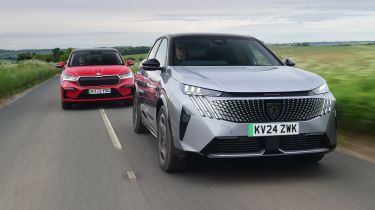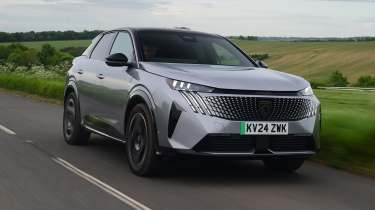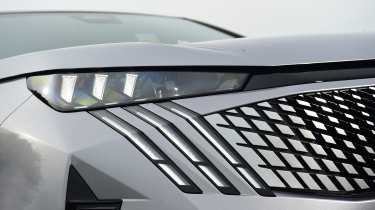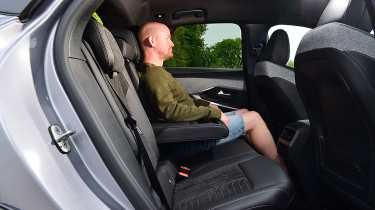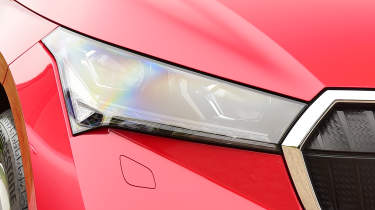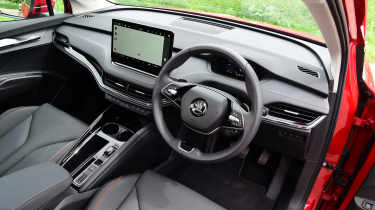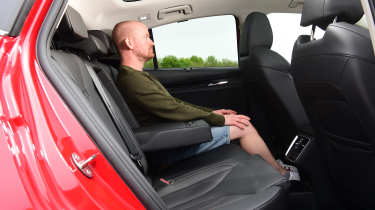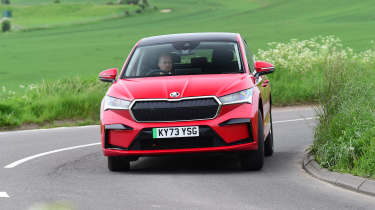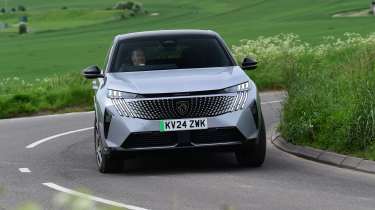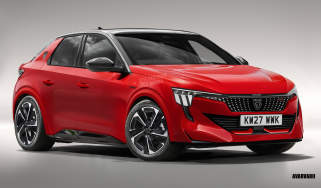Skoda Enyaq Coupe vs Peugeot E-3008: svelte electric SUVs fight for glory
The new Peugeot 3008 introduces electric drive to the line-up – but is the EV better than a Skoda Enyaq?
Peugeot is experiencing a bit of a renaissance at the moment. At its peak in the eighties and nineties it churned out plenty of class leaders, but the company declined in the noughties when its cars fell short of rivals. It turned a corner in the late 2010s, though, morphing into a brand that today troubles the premium marques for design and quality.
Its latest model is more significant than most, too. The last 3008 announced the brand’s return to form louder than any other, with a premium cabin, a fine drive and plenty of space. It was so good that it was named best mid-size SUV in our 2017 New Car Awards.
So expectations are high for its replacement, and this time, the 3008 comes with a choice of internal-combustion, plug-in hybrid or fully-electric powertrain options.
To see if the electric E-3008 has pushed things even further, we’ve lined it up against one of the best family EVs on sale, the Skoda Enyaq, which we’re testing in Coupe form to match the rakish newcomer.
| Peugeot E-3008 | Skoda Enyaq Coupe | |
| Price: | £49,650 | £46,440 |
| Powertrain: | 1x e-motor, 207bhp | 1x e-motor, 282bhp |
| 0-62mph: | 8.8 seconds | 6.7 seconds |
| Efficiency: | 3.9 miles/kWh | 3.8 miles/kWh |
| Official range: | 326 miles | 353 miles |
| Charging: | 160kW | 135kW |
Peugeot E-3008
We're testing the Peugeot E-3008 in top-spec GT trim, which starts from £49,650. With the extras added to this test car, its total cost is £51,700.
Tech highlights
The new 3008 is an important launch for Peugeot, but it’s just as significant for parent company Stellantis. That’s because it’s the first car to arrive on the market that uses the group’s latest STLA architecture. This £25.7 billion platform will be available in four sizes – Small, Medium (as used by the 3008), Large and Frame – and will be adopted by a wide range of brands and models.
Two battery chemistries, a maximum potential range of up to 500 miles and the ability to underpin everything from superminis to pick-up trucks – made possible by front, rear and four-wheel-drive layouts – means that the group aims to produce up to two million STLA-based units per year once it’s in full swing. The E-3008 tested here gives us a crucial first chance to see how this tech performs by wading into an already hugely competitive class.
From launch, the E-3008 comes with a 73kWh battery and a 400-volt electrical system. This sends its energy to a front mounted motor that offers up 207bhp. A larger battery and more powerful options will join the line-up later.
Regardless of layout, Peugeot claims that the E-3008 offers class-leading efficiency; a WLTP range of 326 miles is competitive when you consider the relatively modest battery capacity for this class. All versions of the E-3008 come with an on-board 11kW charger as standard, but a heat pump is a £700 option.
Safety: Euro NCAP has yet to test the E-3008, but every model will be equipped as standard with a driver attention alert system, lane-keeping assist, traffic-sign recognition and cruise control. Adaptive cruise control is standard on the top-
spec GT model, and is part of the £700 360-Degree Vision & Drive Assist Pack on Allure models.
On the road
The E-3008 doesn’t live up to expectations when it comes to the driving experience, with one area in particular falling well short of the class best.
Around town: The car’s shortcomings can be felt as soon as you hit the first bump. The E-3008’s ride is very firm, and every road imperfection, drain cover and pothole jostles the car and its occupants. While the chassis does a fine job of isolating the noise from each of those impacts, the suspension set-up is much too unforgiving for a family car.
A & B-roads: There are other areas where the E-3008’s drive has room for improvement. The steering has quite a bit of resistance around the straight ahead, and this feels even worse when the rack is weighted up in Sport mode. Quick responses combined with that firm suspension keep body roll in check, though, and on smooth roads the E-3008 feels stable with plenty of grip.
While a wave of needlessly powerful EVs have skewed what is considered a necessary level of performance for a family car, the E-3008 does struggle a little bit with the output it offers. It’s sprightly enough off the line, but the car’s acceleration tails off significantly around 40-50mph, so overtaking needs more forward planning than in many alternatives, whether they’re powered by petrol or electricity.
There’s nothing wrong with the car’s throttle response, but there isn’t much urge even if you use the full travel of the throttle pedal. The brakes are strong, though, and paddles to adjust the brake regeneration are a welcome addition.
Motorway: Refinement is one of the 3008’s strongest suits, with both wind and road noise well suppressed, even at higher speeds. Stability is great, too, although the ride still doesn’t fully settle down at the motorway limit.
Ownership
The previous 3008 had one of the most distinctive and stylish cabins in its class, but the wow factor has been taken to another level with this new model. In terms of design, there’s nothing like it for the cash, with a dramatically sweeping dash design cocooning the driver in something that feels more like a spaceship than a family SUV.
But it’s the use of materials and the quality of the finish that really set a standard here; Peugeot has built a car that should leave some of the premium German manufacturers feeling like they should try a little harder.
True to Peugeot form, however, the ergonomics won’t suit everyone. A small-diameter steering wheel is positioned quite low beneath a digital driver’s display that’s placed high on the dash, so you look at your speed and other driver information above the top of the wheel rim, rather than through it, as on most other cars. The problem comes when that steering wheel needs to be positioned higher for comfort, because in some cases it can block your view of the instruments. It really depends on your height and build as to whether this layout works for you, so it’s important to try before you buy.
Storage: Peugeot claims a whopping 34 litres of interior storage inside the 3008, and a large portion of that is formed by two huge bins between the front seats – one of which, due to the swoopy dashboard shape, is much easier for the passenger to access than the driver. The door bins are carpeted up front so items don’t rattle about, but the glovebox is small because some of the space is robbed by the fuses located in the same place.
Practicality
The E-3008’s interior and storage capacities rank among the best in the class, although headroom could be better.
Rear Space: Kneeroom is very generous, and there’s plenty of space for feet beneath the front seats. A rakish roofline means headroom is a little compromised, so anyone over six-feet tall might find their head brushing the headlining. The centre seat isn’t the most comfortable because the backrest is hard.
Boot: At 588 litres, we have no complaints about the E-3008’s vast capacity. There’s plenty of hidden space when the false floor is in its highest position, or you can lower it (a little fiddly due to its unusual spring-loaded locating slots) for a much deeper load area. The rear seats don’t quite fold completely flat, but in two-seat mode the overall volume grows to 1,663 litres.
What to buy?
Which version we’d choose
- Powertrains: The E-3008 currently offers just the one motor and battery combination, but the range will soon be bolstered by a dual-motor model with 316bhp and then a long-range model with 227bhp and a 98kWh battery. The 3008 also launches with a hybrid petrol option, with PHEVs following later.
- Trim: There are two options, but since the Allure model has wheels that are an inch smaller in diameter, we’d forego the GT’s front parking sensors, powered tailgate and heated front seats for the prospect of a smoother ride, especially with standard kit levels remaining high.
- Our choice: Well equipped Allure trim offers the best value for money for buyers.
Skoda Enyaq Coupe
In Coupe form the Skoda Enyaq starts from £46,440. A few option boxes were ticked when choosing the specification for our test car, so the price comes to £49,850, which is just £200 more than the Peugeot before any extras are added.
Tech highlights
While the E-3008 is set to be the first of many cars within its group to use a single platform, the Volkswagen Group is a little further ahead of the curve with a similar strategy. Its MEB underpinnings now cover a wide range of models, from small hatchbacks such as the Cupra Born to the Volkswagen ID. Buzz Cargo van, with the Enyaq taking a middle ground between those two extremes.
The model we have here is fitted with the largest battery currently available to MEB, although with a usable capacity of 77kWh, it’s not much larger than what will eventually be the smaller of two options for the E-3008.
There’s a big difference with the arrangement of the electric motors. While the Peugeot uses a front-mounted layout, the Skoda’s sits at the back and drives the rear axle. With a total of 282bhp and 545Nm of torque, it’s vastly more powerful, with a clear 70bhp and 200Nm more to offer.
As with the Peugeot, a heat pump is offered as an option when many smaller and more affordable EVs now come with one fitted as standard. At £1,025, it’s a very pricey extra, too.
Safety: A five-star rating was awarded to the Enyaq when Euro NCAP assessed it in 2021. Of all the cars tested in the year of its assessment, its 94 per cent score in the Adult Occupant Protection category was the third best overall, while its Child Occupant Protection score was a top-six result. Adaptive cruise control and blind-spot detection are standard throughout the Enyaq Coupe range.
On the road
Even in its weakest areas, the Enyaq is a close match to the Peugeot from behind the wheel. In its strongest areas, it pulls out a big lead over its rival.
Around town: Jump from the Peugeot into the Skoda, and within the first few yards it’s clear just how much more smoothly the Enyaq rides over bumps. It’s not overly floaty or wallowy, but it manages to filter out undulations and drain
covers that jar the Peugeot’s occupants.
If we’re being hyper-critical, then the Enyaq transmits a slight high-frequency vibration through the suspension at most speeds, but this is definitely the car we’d rather spend time in. Even though the Peugeot feels more harsh, it’s very slightly better at isolating the noise of those knocks from the cabin.
A & B-roads: Despite this smoother ride, the Enyaq Coupé doesn’t feel significantly less capable on a twisty road. A rear-wheel-drive layout makes the car feel neutral and predictable through turns, and although the steering isn’t as quick as the Peugeot’s, its level of response feels more appropriate for a car of this type.
But the steering is the only thing that’s slower. At 6.7 seconds, the Enyaq’s 0-62mph time beats the Peugeot’s by 2.1 seconds, and it feels faster, too. Throttle response is lively, yet a long pedal travel makes it easy to modulate, and there’s more punch when needed. The brakes are strong, and transfer between regen and mechanical braking slickly.
Motorway: At higher speeds, the Skoda transmits slightly more noise into the cabin than the E-3008, but both cars are very hushed on a motorway cruise. The Skoda’s more relaxed steering ratio makes it feel a little easier to drive, though, with fewer steering corrections needed.
Ownership
We've loudly sung the praises of the Peugeot’s cabin, but the Enyaq’s design and finish are hardly shabby. It certainly looks a little more conventional than its rival, but some would argue that’s a good thing; the small digital instrument display is always easy to read through the space beneath the top of the steering wheel rim, and many of the basic controls are located on a single bank of switches beneath the touchscreen. There’s loads of adjustment for the wheel and driver’s seat, and overall visibility is a little more open than the E-3008.
Build quality feels sturdy, and when combined with soft-touch materials and attention to detail such as the frameless rear-view mirror, the Enyaq manages to give a great impression of expense wherever you look. The two-spoke steering wheel is an impressive piece of design; not only is it great to hold, but the mix of physical buttons and scroll wheels on each spoke is very intuitive to use. Driver-assist systems can be easily accessed via a button on the steering wheel.
Storage: The Enyaq is available with a range of modular storage cubbies, including a removable plastic tray that sits in the centre of the floor ahead of the back seats. Further forward, there’s a 6.2-litre cubby beneath the adjustable front centre armrest, while each of the carpeted door bins offers a further 4.7 litres of capacity – there’s even a removable mini waste bin for the sort of rubbish that accumulates during everyday use. As with the E-3008, the glove compartment’s size is compromised by the location of the fuses.
Practicality
The Enyaq Coupe has a slight edge over the E-3008 for passenger space, and it runs it close in the boot, too, but a regular Enyaq SUV is even roomier.
Rear Space: The Skoda’s rear bench offers up near-identical kneeroom to the Peugeot’s, but the Enyaq holds an edge when it comes to headroom – just enough to make a real difference for taller occupants. Both cars have flat floors and plenty of foot room under the front seats, but the Enyaq is marginally tighter here.
Boot: The rakish roofline trims 15 litres from the Enyaq Coupe's boot capacity when compared with the SUV variant. Still, at 570 litres overall, it’s only slightly behind the Peugeot. The rear seats drop a little flatter in the Skoda, but unlike the three-way split of the E-3008’s seats, there is only a 60:40 split here. It has a ski hatch for loading longer items, though.
What to buy?
Which version we’d choose
- Powertrains: The Enyaq Coupe doesn’t come with the smaller 60kWh battery found in the standard SUV, so its entry price is much higher. This 282bhp/77kWh combination will be more than enough for most, but buyers can also choose from a four-wheel-drive model with the same power, or the hot vRS, which turns the wick up to 335bhp.
- Trim: The range kicks off with the Edition tested here, above which is the luxury L&K and the performance-inspired styling of SportLine. The vRS tops the range, costing £8,380 more than the base Edition.
- Our choice: There’s little need to climb any higher up the range than this 85 Edition trim.
Results
Which car comes out on top?
Winner: Skoda Enyaq Coupe
Three years after its launch, the Enyaq proves that it’s still the class of the family EV field. It ticks all the boxes that matter to most buyers; it’s spacious, comfortable, fairly efficient (if slightly behind the Peugeot) and well equipped, but brings the added bonuses of a smart cabin and plenty of power.
The main issue we have with the Coupe variant is that you can get all of its strong points in the Enyaq SUV, which also has a bigger boot and like-for-like costs £2,000 less.
| Pros | Cons |
| Strong performance | Slight fidget to the ride |
| Soothing driving experience | No physical climate controls |
| Interior space | Peugeot charges faster |
| Build quality | Enyaq SUV is cheaper |
Runner-up: Peugeot E-3008
While Peugeot has been a brand on an upward trajectory for a few years, that appears to have stalled a little with the E-3008. There are huge pluses – notably its interior design and quality, along with efficiency and charge speeds – but in other areas, there are some big flaws.
We could live with the average performance or odd steering feel in isolation, but combining the two with a ride that’s far too firm for a car of this type means that Peugeot has missed the mark here.
| Pros | Cons |
| Stunning cabin | Harsh ride |
| Lots of standard equipment | Underwhelming pace |
| Strong efficiency | Unnatural steering feel |
| Fast charging speeds | Some fiddly screen menus |
Rivals and other options
The Enyaq Coupe wins our test, but what else is out there?
- Same class: Tesla model Y
- Same money: Renault Scenic
- Used: Jaguar I-Pace
- Used: BMW iX3
- Coming soon: Cupra Tavascan
The great debate
The Auto Express team have their say…
John McIlroy, editor-at-large: If you want the space, style and pace of the Skoda but want to avoid an SUV body, then both the Hyundai Ioniq 5 and Kia EV6 make highly compelling alternatives. By the end of the year the EV6 is set to get even stronger, with a bigger battery and updated looks.
Richard Ingram, deputy editor: The E-3008’s exterior colour palette isn’t the most thrilling, with a limited choice of greyscale hues. So it’s great that the most interesting shade, the oily/teal Obsession Blue, is the one no-cost option offered to buyers. Pick the good colour while saving some cash: win-win!
Dawn Grant, picture editor: Peugeot has clearly got some things very right with the new E-3008, but there are other areas that really need to improve. When the range expands with a more potent dual-motor model, our performance gripes should be fixed; it’ll be interesting to see if that car is more engaging to drive, too.
Paul Barker, editor: Skoda’s EV range is set to be bolstered soon by the Elroq, a Karoq-sized SUV that will slot into the range just below the Enyaq. We expect to find out more very soon, but the 4.5-metre-long family car will use a variant of the same MEB architecture that underpins the Enyaq.
Dean Gibson, senior test editor: At some point along the line, Peugeot’s engineers seemingly forgot how to make great steering. A precise, well weighted rack is what made even its humdrum hatchbacks of old feel engaging to drive; cars such as the E-3008 feel numb and artificial in comparison.
Which would you buy? Let us know in the comments section below…
Specs and prices
| Peugeot E-3008 73kWh GT | Skoda Enyaq Coupe 85 Edition | |
| On the road price/as tested | £49,650/£51,700 | £46,440/£49,850 |
| Powertrain | 1x electric motor/lithium-ion battery | 1x electric motor/lithium-ion battery |
| Power/torque | 212bhp/345Nm | 282bhp/545Nm |
| Transmission | Single-speed auto/fwd | Single-speed auto/rwd |
| Battery capacity/usable | 73/73kWh | 82/77kWh |
| Length/wheelbase | 4,542/2,739mm | 4,653/2,768mm |
| Height/width | 1,641/1,895mm | 1,606/1,879mm |
| Boot capacity (seats up/down) | 588/1,663 litres | 570/1,610 litres |
| Kerbweight/payload/towing weight | 2,108/532/1,250kg | 2,145/588/1,200kg |
| Turning circle/spare wheel | 10.6 metres/repair kit | 10.2 metres/repair kit |
| Basic warranty (miles)/recovery | 3yrs (60k)/8yrs | 3yrs (60k)/3yrs |
| NCAP: Adult/child/ped./assist/stars | N/A | 91/89/71/82/5 (2021) |
| 0-62mph/top speed | 8.8 seconds/105mph | 6.7 seconds/111mph |
| Auto Express economy/range | 3.9 miles/kWh/285 miles | 3.8 miles/kWh/293 miles |
| Claimed range (WLTP) | 326 miles | 353 miles |
| Charging capability | 7.2/160kW | 7.2/135kW |
| Charging time | 10h (est)/20min (20-80%) | 13h/29 min (0-80%) |
| CO2/tax bracket | 0g/km/2% | 0g/km/2% |
| Number of airbags/Isofix points | Six/two | Seven/three |
| Parking sensors/camera | Front & rear/360 degrees | Front & rear/yes |
| Lane-keep assist/blindspot/AEB | Yes/yes/yes | Yes/yes/yes |
| Climate control/adaptive cruise | Dual-zone/yes | Dual-zone/yes |
| Leather/heated seats/wheel | £1,600/yes/yes | £1,650/yes/yes |
| Metallic paint/LED lights | £750/yes | £650/yes |
| Keyless entry & go/powered tailgate | Yes/yes | Yes/yes |
| Sat-nav/digital dashboard/USBs | Yes/yes/four | Yes/yes/four |
| Online services/wireless charging | Yes/yes | Yes/yes |
| Wireless CarPlay/Android Auto | Yes/yes | Yes/yes |

